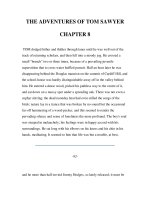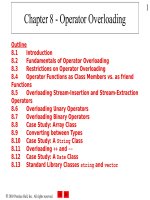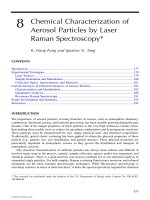Chapter 8 Gear Train.pdf
Bạn đang xem bản rút gọn của tài liệu. Xem và tải ngay bản đầy đủ của tài liệu tại đây (1.66 MB, 9 trang )
1 28/10/2021
1
Theoretical contents
I. Overview
II. Classification
III. Transmission Ratio
IV. Problem
TS. Phan Cơng Bình 28-Oct-21
2
1. Overview
The gears are matching together in series or parallel.
Transmitting and distributing motion
Increasing or decreasing rotation speed
Large ratio and far centre distance
Planar Universal
TS. Phan Cơng Bình 28-Oct-21
3
2. Classification.
Gear drives system
(Planar, universal)
Simple gear Epicyclic
Planetary Open Close
Differential differential
Combination
TS. Phan Cơng Bình 28-Oct-21
4 28/10/2021
2
2. Classification.
a. Simple gear drive system (hệ thường)
Centerlines of all gears are fixed
TS. Phan Cơng Bình 28-Oct-21
5
2. Classification.
b. Epicyclic gear system (hệ ngoại luân)
Epicyclic gear system has at least 1 gear’s centerline motion .
TS. Phan Cơng Bình 28-Oct-21
6
2. Classification.
b. Epicyclic gear system
Planetary gear (hành tinh) is at least 1 fixed center gear
Z2 Z’2
Z2 Z’2
C Z3
C
Z1
Z1 Z3
Degree of freedom:
W = 3𝑛 − 2𝑝 − 𝑝4 = 3.3 − 2.3 − 2 = 1
The gear that the centerline is in the main axis of the system is so-called center gear
TS. Phan Cơng Bình 28-Oct-21
7 28/10/2021
3
2. Classification.
b. Epicyclic gear system
Open differential: (Vi sai hở) All center gears are moveable
TS. Phan Cơng Bình 28-Oct-21
8 Z2
2. Classification. Z1 C
b. Epicyclic gear system Z3
Open differential All center gears are moveable
𝒁𝒃
Z3
Z1
Z’2
Zb
Za
Z2 Z’2
𝒁𝒂 C C
Degree of freedom:
W = 3𝑛 − 2𝑝 − 𝑝4 = 3.4 − 2.4 − 2 = 2 Z1
Z3
TS. Phan Cơng Bình 28-Oct-21
9
2. Classification.
b. Epicyclic gear system
Close differential (vi sai kín) 2 in 3 kinematic links (C, Z1, Z3 ) are engaged
each other
Z2 Z’2 Z2
Z’3
Z’1 C Z’2
C
Z5
Z1 Z3 Z1 Z3 Z’3
Z4 Z’4
Z’4 Z4
Degree of freedom:
W = 3𝑛 − 2𝑝 − 𝑝4 = 3.5 − 2.5 − 4 = 1
TS. Phan Cơng Bình 28-Oct-21
10 28/10/2021
4
2. Classification.
c. Combination gear system
Simple gearing coupling with a epicyclic (planetary, open differential, close
differential)
Z2
Zb Z’2
C Z’3
Z3
Z1
Za Zd
TS. Phan Cơng Bình 28-Oct-21
11
3. Transmission ratio
a. Simple gear system
Ratio of 1 gearing
u12 ω1 n1 Z2 (+): Inside engage (𝜔 ↑↑ 𝜔 )
ω2 n2 Z1 (−): Outside engage (𝜔 ↑↓ 𝜔 )
Ratio of simple gear system
u1n ω1 n1 () Zbd
ωn nn Zd
(−1)k Planar. where, k is number of outside engage
±
For Universal gear (bevel gear). Determining (+) (-) in reality
• If 𝑢 < 0 gear 1 and n gear are opposite direction.
• If 𝑢 > 0 gear 1 and n gear are same direction.
TS. Phan Công Bình 28-Oct-21
12 Z4
3. Transmission ratio Z3
a. Simple gear system Z’3
Exercise Z’2
Z1
Planary
Z2
Universal Z’2 Z2
C
Z3 Given:
Z’3 Z1 = 20 Z2 = 40 Z’2= 20
Z1
Z3 = 50 Z’3= 40 Z4 = 20
Calculating u13 ?
Z4
TS. Phan Cơng Bình 28-Oct-21
13 28/10/2021
5
3. Transmission ratio
b. Epicyclic system
the angular velocities of
the various gears in the
system is taken by
transforming the arm C
into stationary observer
• If arm C is stationary, angular velocity of each link will be −𝜔
𝐾ℎâ𝑢 1 𝑍1 𝜔 − 𝜔
𝐾ℎâ𝑢 2 (𝑍2 & 𝑍′2) 𝜔 − 𝜔
Kℎâ𝑢 3 (𝑍3) 𝜔 − 𝜔
𝐾ℎâ𝑢 4 (𝑪): 0
TS. Phan Cơng Bình 28-Oct-21
14
3. Transmission ratio
b. Epicyclic system
Planetary gear
Z2 Z’2 In reference frame C
u13/C 1 c 1 1
3 c c
C 0
In absolute system 𝑢 = −1 . =5
Z1 Z3 u1C 1 4
c
Given: Z1=20; Z2=60;
Z’2=30; Z3=50 (Arm C and Z1 are opposite direction)
𝑢 = =?
TS. Phan Cơng Bình 28-Oct-21
15
3. Transmission ratio
b. Epicyclic system
Open differential
Z2 Z’2
Given: Z1=20; Z2=60; Z’2=30; Z3=50
ω =8 rad/s ω =1 rad/s
C Z and C are the opposite direction
Calculating:
ω =? rad/s and direction Z3?
Z1 Z3
TS. Phan Cơng Bình 28-Oct-21
16 28/10/2021
6
3. Transmission ratio
b. Epicyclic system
Open differential u13/C 1 c
In reference frame C 3 c
In absolute system u13 12 Z2 Z3 5
Z1 Z2'
where, 𝑢 / =𝑢
3 1 4c
5
Assuming direction Z1 + (8) 4(1) 4
Or C - 5 5
(Z3 and Z1 are the same direction)
TS. Phan Cơng Bình 28-Oct-21
17
3. Transmission ratio
b. Epicyclic system
Close differential
Z2 Z’2
In reference frame C 𝑢 / =
Z’3 ZZ
𝑢 = −1 . = 6
Z’1 C Z Z′
ω − ω = 6 (ω − ω ) =>ω =
Z1 Z3 Close differential: 𝑢 = = −1 Z’4 . Z’3=+4
Z’1 Z4
=>ω = + ;nên ω = + = + rad/s
Z’4 Z4
Given: Z1=20; Z2=60; Z’2=20; Z3=40 Z’1=20; Z’4=40; Z4=20; Z’3=40 ω =8 rad/s
Calculating ω =? rad/s
TS. Phan Cơng Bình 28-Oct-21
18
3. Transmission ratio
c. Combination
Z1
𝑈 = 𝑈 .𝑈
𝑍
𝑈 =−
𝑍
𝑈= ω Z’2 Z4
ω ω −ω ω Z2
𝑈 / =ω −ω =1−ω
𝑈 = (−1) 𝑍 𝑍 −𝑍 Z3
=
𝑍′ 𝑍 𝑍′
Determining the sign ( + or -) Simple gear Planetary gear
following the ‘’k’’ indication
TS. Phan Cơng Bình 28-Oct-21
19 28/10/2021
7
Problem Solution Method
1. Determine kind of gear train
Planar: based on pair of external gearing k
Space: based on realistic schematic diagram
2. Epicyclic gear train
u13/C ω1 ωC Planetary: ω = 0
ω3 ωC
' Z2 Z3 Open Given 2 of 3 speed C, Z1, Z3
Z1 Z2 differential Direction (the same or opposite)
Close
differential Close differential equation
3. Combination Solve the Epicyclic
Determine the remained variable in Simple train
Note: The notation must be based on the realistic schematic diagram
TS. Phan Cơng Bình 28-Oct-21
20 Problem
Q 1. 𝐴𝑙𝑙 𝑔𝑒𝑎𝑟 ℎ𝑎𝑣𝑒 𝑡ℎ𝑒 𝑠𝑎𝑚𝑒 𝑚𝑜𝑑ule.
𝐻𝑒𝑟𝑒, Z = 2Z , Z = 20, Z = 40, Z′ = 35, Z = 70 teeth
Gear Z has n = 120 𝑟𝑝𝑚 , n = 70 𝑟𝑝𝑚 ,
𝑍 𝑎𝑛𝑑 𝑙𝑖𝑛𝑘 𝐶 ℎ𝑎𝑣𝑒 𝑡ℎ𝑒 𝑠𝑎𝑚𝑒 𝑑𝑖𝑟𝑒𝑐𝑡𝑖𝑜𝑛
D𝐞𝐭𝐞𝐫𝐦𝐢𝐧𝐞 𝑉𝑒𝑙𝑜𝑐𝑖𝑡𝑦 𝑛 𝑎𝑛𝑑 𝑑𝑖𝑟𝑒𝑐𝑡𝑖𝑜𝑛 𝑜𝑓 𝑍 .
TS. Phan Cơng Bình 28-Oct-21
21 Problem
Solution Q1. u13/C n1 nC na 3nC
n3 nC (1) & (2) n3 2
Epicyclic gear
(-1) ' 2 Z2 Z3 4 4
Simple gear Z1 Z2
Assumption C + n3 n1 3nC (1)
or Za + 4
uab na Zb 2
nb Za
n1 nb na (2)
2
(120) 3(70)
n3 2
4 37,5 v / p
Conclusion
Z3 rotates at 37,5 rpm and the same direction Arm C
TS. Phan Cơng Bình 28-Oct-21
22 Z’2 Z2 28/10/2021
C Zb 8
Problem Z3 Za
Q 2. Z1
Given: Z1=20; Z2=80; Z’2=40; Z3=40
Z = 2Z , n = 400 𝑟𝑝𝑚 , n = 200 𝑟𝑝𝑚
Z and C are opposite direction of rotation .
Calculate:
a. Degree of freedom W of gear?
b. Direction of gear?
c. Rotation speed n3 of gear Z3?
d. Rotation speed nb of gear Zb?
TS. Phan Cơng Bình 28-Oct-21
23
Problem
Solution 2. u13/C n1 nC ' Z2 Z3 4
Z2 n3 nC Z1 Z2
Z’2
C Z3 n3 5nC n1 (1)
Zb 4
Z1
uab na Zb 2
nb Za
nc nb na (2)
2
5na n1
Za (1) & (2) n3 2
4
Assume Z1 + 5(400) (200)
C- Za + n3 2
Conclusion: 4
300 v / p
Z3 rotates at 300 rpm and opposite direction Z1 (or the same Arm C)
TS. Phan Cơng Bình 28-Oct-21
24 Problem
Q 3. Z1= Z’2= Z’3= 50, Z2= Z3= 25,
Z4= 100, Z’4= 20, Z5= 40.
Rotation speed n1= 800 (rpm)
Calculating:
a. Degree of freedom W of gear?
b. Rotation speed n3 of gear Z3?
c. Rotation speed n5 of gear Z5?
TS. Phan Cơng Bình 28-Oct-21
25 Problem 28/10/2021
9
Q 4. Za= 25, Zb= 50, 𝑍 = 25, 𝑍 = 50, 𝑍′ = 15, 𝑍 = 30.
Gear Za and arm C turn same direction.
Rotation speed na= 200 (rpm), nc= 100 (rpm).
Determine the direction and rotation speed n3 of gear Z3?
TS. Phan Cơng Bình 28-Oct-21
26
IV Problem
Q5. Z1= Z5= Z4= 30, Z2=60, Z3= 80, Z6=140.
n1= 960 rpm. Determine
a) DOF of the given gear train?
b) nC and rotating direction of Arm C
(compared to direction of Z1)?
TS. Phan Cơng Bình 28-Oct-21
27
TS. Phan Cơng Bình 28-Oct-21









